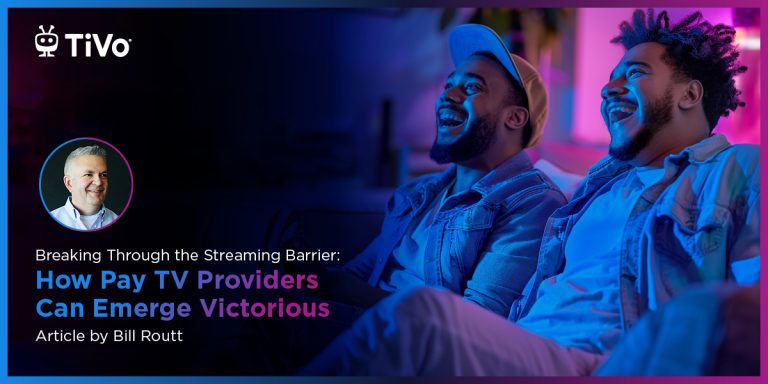By: Bill Routt
Up until the last decade, the television consumption model had been relatively stable for more than 40 years. The traditional cable provider model once reigned supreme as the sole way to watch television for decades. However, as streaming services started emerging as new players and now leaders over the last decade, they gave traditional cable providers competition for how people are able to watch content – no longer having to wait for a show to air mid-week or for reruns but giving consumers content 24/7. This once-settled landscape started undergoing a seismic transformation amidst the streaming wars, turning the traditional model on its head. With the onset of streaming, that viewership is now shared among a variety of sources. From SVOD and Pay TV to FAST/AVOD, the video streaming landscape has evolved significantly. According to the latest TiVo Video Trends Report, consumers hold an average of 11.1 video services, spanning both paid and non-paid platforms.
Consumers watch 4.7 hours of video a day, up from 4.4 hours a year ago. Ninety percent of the time consumers are watching paid content, with FAST/AVOD accounting for only 10.3% of the viewing time. Amid the rising cost of content, people are re-evaluating what they pay, leading to a steady increase in the popularity of non-paid services. SVOD, FAST/AVOD, vMVPDs, and Pay TV providers are all vying for consumers’ time and, in the case of paid services, their money. This competition is rapidly intensifying, driving innovation and consumer choice to new heights.
With the fierce competition, Pay TV providers have been asking how they can win in the face of these pressures. Contrary to some in the market, this isn’t an obituary for Pay TV as the streaming wars continue. This evolving landscape is in fact an opportunity for Pay TV providers to shift their model to evolve with consumer preferences – opening the door for a major win.
The Case for Super Aggregation
With consumers tuning into video content across a multitude of platforms, frustration is mounting as they struggle to navigate the expanding array of options. The lack of one centralized location to find content is creating discovery friction for consumers. Only 19% of consumers know what they want to watch when they turn on their television or mobile device – a staggeringly low number considering how much video people are watching each day.
This problem has identified a need for a single home screen that offers super aggregation across all a consumer’s video content – no matter how they’re watching TV. If a Pay TV provider were to step in and provide this, it would create a best-in-class user experience that eliminates friction and delivers value to its customers. And more than just the value add for consumers, it also greatly benefits the provider’s bottom line.
Whoever owns the home screen experience will also unlock a new monetization axis as consumers spend less time app-hopping. By offering a single, unified user experience that empowers consumers to effortlessly discover, providers will make it easy to find, watch and enjoy all their favorite content. In turn, this would keep consumers on the home screen while building influence and mindshare with users. Owning the home screen is the new “owning HDMI 1,” which was the drive in the television industry five years ago. Whichever service provider was plugged into HDMI 1 drove most of the consumer’s experience when it came to watching TV shows and movies, with consumers not wanting the hassle of switching between HDMI 1 and HDMI 2. Now people will grow accustomed to finding everything on the home screen and not having to switch between apps, similar to staying on HDMI 1.
This is where Pay TV providers can step in and be the leaders at creating this experience – and I believe they are uniquely positioned to do just this. With a simple set-top box, Pay TV providers can super aggregate across SVOD, FAST/AVOD, live TV content and more, creating a truly unified experience. This new funnel will become increasingly important for Pay TV economics going forward, so the earlier an adopter a provider can be will only benefit them in the long run. And this capability isn’t far in the future – Pay TV providers can provide this experience to users today.
A Versatile Solution for the Future of Pay TV
The future of what’s possible for Pay TV is now and TiVo is helping Pay TV providers make this a reality. Pay TV providers can utilize TiVo Broadband to own the home screen by delivering a solution that allows consumers to seamlessly transition back and forth between TiVo Broadband and IPTV through one home screen experience. By using a versatile solution like TiVo Broadband, service providers can help consumers resubscribe and prevent users from cutting the cord altogether.
Cord revivers, or consumers who resubscribe their Pay TV subscriptions, make up almost 30% of Pay TV customers. They come back because they couldn’t find all the content they wanted in one place and are looking for that bundle experience. By giving them this flexibility with TiVo Broadband, Pay TV providers could easily capture an even higher percentage of this audience.
In fact, more would opt-in and stay with a Pay TV service if they didn’t have to sign a long-term contract. If Pay TV providers look to meet these customers where they are, they’ll be opening more doors to users coming to their service and prevent subscribers from cutting the cord altogether. These future “part-time” Pay TV customers might have a full linear offering during a portion of the year, like college football season in the fall, and then switch to a non-traditional video offering like TiVo Broadband during the off-season.
By giving users this flexibility, providers will keep more consumers happy and unlock a new market they may have not previously reached. Pay TV providers will be able to stay even more relevant in the streaming wars. They’ll provide immense value to consumers and benefit their bottom line as a business by creating a new monetization axis on the home screen in this next frontier of television.


Comments are closed.